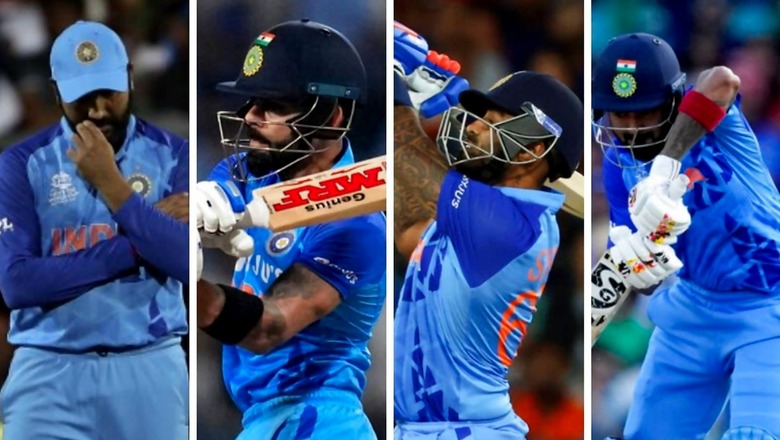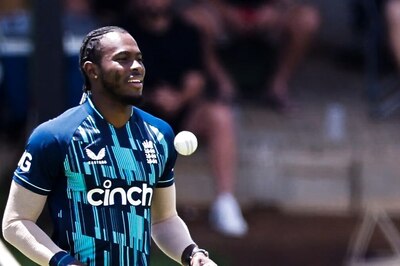
views
India’s much-talked-about campaign at the ICC Men’s T20 World Cup 2022 has come to an end with a semifinal defeat to England. Their build-up to the showpiece event was severely dented when Jasprit Bumrah and Ravindra Jadeja were ruled out due to injuries with few even ruling out India’s chances of winning the title altogether. A nerve-shredding victory in their opening match put India firmly in the bracket of tournament favourites though.
T20 World Cup 2022: Full Coverage | Schedule | Results | Points Table | Gallery
Weaknesses that were overshadowed by the individual brilliances of Virat Kohli, Suryakumar Yadav, Hardik Pandya and Arshdeep Singh came to haunt India in the semifinal clash resulting in a crushing defeat. A review will follow and it’s quite likely we have seen the last of a few senior India players, at least in the T20I format.
Before that, it’s time to rate how the 15-man squad fared individually. Out of these, Harshal Patel and Yuzvendra Chahal were the only two players not to get a single game and hence are out of the scope of this piece.
KL Rahul – 2/10
The opener did score two half-centuries but both came against relatively weaker opponents – the Netherlands and Zimbabwe. Overall, he scored 128 runs at 21.33 with a below-par strike rate of 120.75. Clearly, this isn’t something you want from a specialist opener in an era when the top-order batters are expected to set the tone from the first ball itself and never take their foot off the gas.
Rohit Sharma – 3/10
The India captain had a miserable tournament as well. In six innings, he mustered 116 with 53 of them coming against the Netherlands alone. At his peak, Rohit would settle in nicely and then go berserk. In Australia, he was a pale shadow of his old self. Why does he get an extra mark than Rahul? Well, at least he showed intent to be aggressive more often than not.
Virat Kohli – 8/10
India’s most dependable batter throughout the tournament was Kohli. He may have batted at no 3 but every single game, he found himself in the middle inside the Powerplay overs. He’s not someone who is going to hit fours and sixes right from the outset, but knows how to manipulate the field, and convert ones into twos and twos into threes. Excellent fielder barring that horrible slip against South Africa resulting in a dropped catch. He will, in all likeliness, finish as the top run-getter of the tournament with 296 runs from six innings at 98.66 and a middling strike rate of 136.40.
Suryakumar Yadav – 8.5/10
By far, India’s best batter. Suryakumar batted the way a modern-day T20I batters is expected to. He didn’t take much time to settle in and began finding boundaries with ease. Finished as India’s second-highest run-getter with 239 from six innings at 59.75 and a stunning strike rate of 189.68. He put on a show for everyone by unleashing a series of unorthodox, awe-inspiring shots. Against South Africa when the entire batting line-up collapsed, SKY stood stall with a blistering fifty.
Hardik Pandya – 7/10
Pandya, the allrounder, is back to his best. He has been at that level for few months now. And he put in a series of impressive performances in Australia as well. Against Pakistan, his three-wicket burst was vital in halting their late surge. Against England, his quickfire fifty was the reason India managed to put up a respectable total. From five innings, he scored 128 runs and with his medium-pace, took 8 wickets – the second most from India.
Dinesh Karthik – 1/10
It’s safe to assume that Karthik’s T20I career has concluded with the T20 World Cup. His was one of the feel-good stories in the lead up to the tournament as Karthik made a strong case for his inclusion in T20I setup purely as a finisher. That he could keep wickets was a bonus. A designated finisher, he could not provide the late injection of runs. In 3 innings, Karthik managed 14 runs at a strike rate of 63.63. Additionally, his glovework wasn’t up to the mark either.
Ravichandran Ashwin – 5/10
Ashwin was given the preference over Chahal and he dished out a decent show. The offspinner didn’t leak runs and was more often than not tidy. He took six wickets at 25.83, had a strike rate of 19 and an economy of 8.15. While it’s a desirable quality to plug the leakage of runs, it’s become quite clear that teams are able to make up for the slowness in the middle overs by going hammer and tongs in the death should they have wickets in the bank. India’s inability to take wickets in the middle overs remained a weakness.
Mohammed Shami – 5/10
Not part of the original 15-man squad, Shami was beneficiary of Bumrah’s injury. While his exclusion was widely criticised, nobody expected Shami to fill the role that Bumrah plays to the T. Though he didn’t set the stage on fire, Shami didn’t disappoint either. He took 6 wickets from 6 matches at 23.83, had a strike-rate of 20 and was economical – 7.15. Again, the missing link: the ability to take wickets. Take wickets, and put teams under pressure. Didn’t happen too often.
Arshdeep Singh – 7/10
The left-arm pacer continued his rise. He was quite impressive and certainly will serve India for a long time should his progress continue at this rate. Against Pakistan, Arshdeep was sensational with the new ball and finished with 10 wickets from six matches – the most from India. He averaged 15.60, had a strike-rate of 12 and economy of 7.8.
Bhuvneshwar Kumar – 4/10
Quite economical but wickets were missing – just four from six matches. Being one of the senior bowlers in the side, he was expected to lead by example. Bhuvneshwar’s strength is getting the new ball to move and get India early breakthroughs. Twice he took wickets with the new ball. Thrice he went wicketless and that too against the likes of South Africa, Bangladesh and England.
Axar Patel – 3/10
Another beneficiary of an injured player. Axar featured in all but one match at the world cup and it only because Jadeja missed the tournament. Axar brings with him a similar skillset but is not as polished and impactful as his senior teammate. He took three wickets at 38.33, a strike-rate of 26.6 and an economy of 8.62 – the highest among Indian bowlers. With the bat, he managed 9 runs from three innings. In his defense, the allrounder was not fully utilised as a bowler although his propensity to leak runs may have been the biggest reason behind the trend. Seems like he was in the eleven only as a safety net – to add depth to the batting line-up.
Rishabh Pant – 2/10
Harsh to judge the wicketkeeper-batter who played just two matches and his major contribution was serving drinks during breaks as Karthik was persisted with. Pant’s first taste of world cup action came during South Africa clash when Karthik hobbled off the field holding his back and the youngster replaced him behind the stumps. And then Pant got a full game in the inconsequential final Super 12 match against Zimbabwe with India giving him another go in the semifinal too.
Against Zimbabwe, he walked in at no 5 in the 13th over but lasted five deliveries and added 3 runs. In the semifinal, he walked during the 18th over, opened his account with a boundary but was then run out on 6.
Deepak Hooda – 1/10
Hooda was often seen on the field but only as a substitute fielder when an exhausted India fielder needed break. His solitary chance came against South Africa as India hoped to strengthen their batting order against a fearsome pace attack of Kagiso Rabada, Anrich Nortje, Lungi Ngidi and Wayne Parnell. It didn’t work. He faced a total of three deliveries – two of them from Nortje and Hooda resembled a lost soul trying to find a way to get some part of his bat onto the ball but failed miserably to be out caught-behind on 0.
Get the latest Cricket News, Schedule and Cricket Live Scores here



















Comments
0 comment